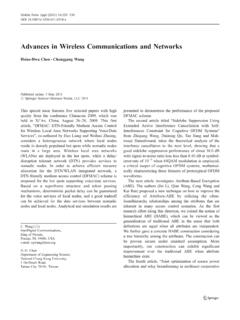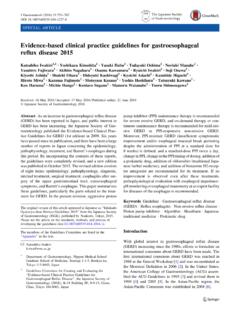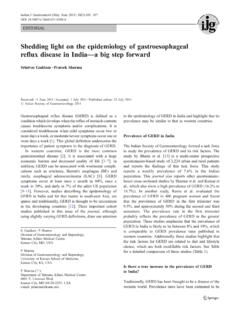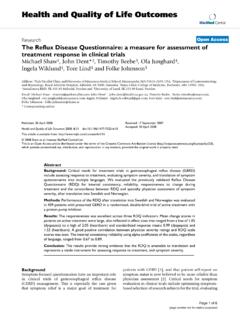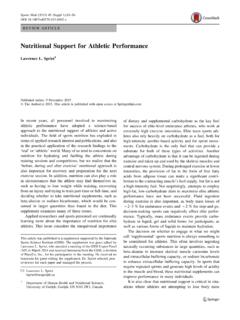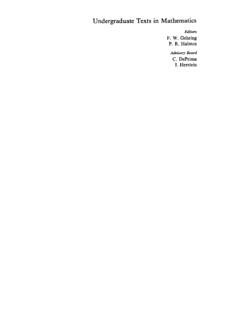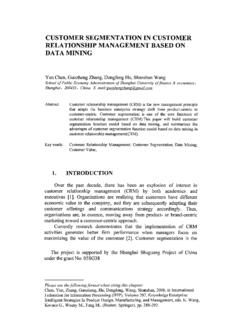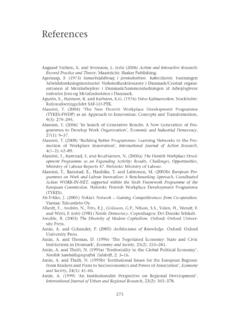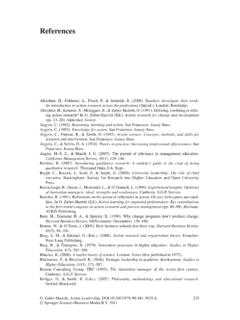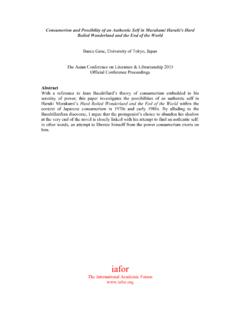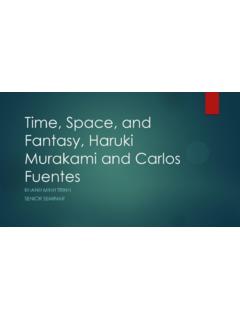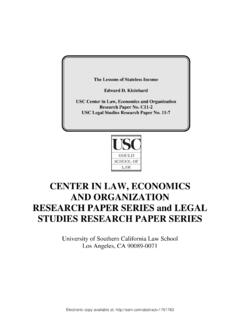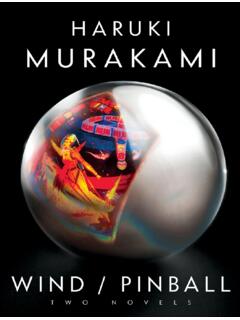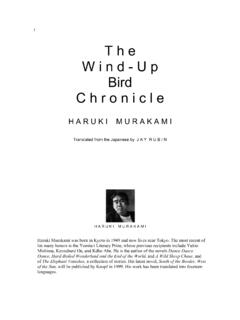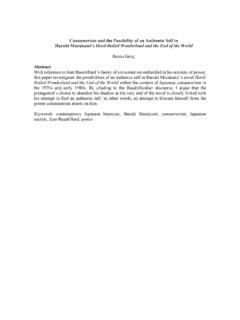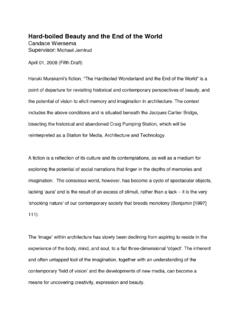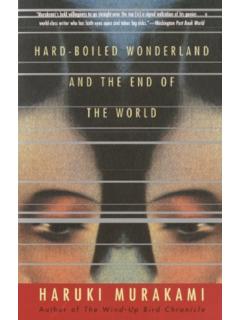Transcription of Haruki Murakami - Springer
1 Haruki Murakami CRITICAL LITERACY TEACHING SERIES: CHALLENGING AUTHORS AND GENRESV olume 7 Series Editor:P. L. Thomas, Furman University, Greenville, USAE ditorial Board:Leila Christenbury, Virginia Commonwealth UniversitySean P. Connors, University of ArkansasJeanne Gerlach, University of Texas-ArlingtonRenita Schmidt, Furman UniversityKaren Stein, University of Rhode IslandShirley Steinberg, University of Calgary; Director of Institute of Youth and Community Studies, University of the West of ScotlandThis series explores in separate volumes major authors and genres through a critical literacy lens that seeks to offer students opportunities as readers and writers to embrace and act upon their own empowerment.
2 Each volume will challenge authors (along with examining authors that are themselves challenging) and genres as well as challenging norms and assumptions associated with those authors works and genres themselves. Further, each volume will confront teachers, students, and scholars by exploring all texts as politically charged mediums of communication. The work of critical educators and scholars will guide each volume, including concerns about silenced voices and texts, marginalized people and perspectives, and normalized ways of being and teaching that ultimately dehumanize students and MurakamiChallenging AuthorsEdited byMatthew C. StrecherSophia University, Tokyo, JapanandPaul L. ThomasFurman University, USAA record for this book is available from the Library of Congress.
3 ISBN: 978-94-6300-460-2 (paperback)ISBN: 978-94-6300-461-9 (hardback)ISBN: 978-94-6300-462-6 (e-book)Published by: Sense Publishers, Box 21858,3001 AW Rotterdam,The chapters in this book have undergone peer image by Ellie WarnerPrinted on acid-free paper All Rights Reserved 2016 Sense Publishers No part of this work may be reproduced, stored in a retrieval system, or transmitted in any form or by any means, electronic, mechanical, photocopying, microfilming, recording or otherwise, without written permission from the Publisher, with the exception of any material supplied specifically for the purpose of being entered and executed on a computer system, for exclusive use by the purchaser of the OF CONTENTSA cknowledgements viiIntroduction: Challenging Murakami ixPaul L.
4 Thomas1. The Haruki Phenomenon and Everyday Cosmopolitanism: Belonging as a Citizen of the World 1 Tomoki Wakatsuki2. Our Old Haruki Murakami and the Experience of Teaching His Works in Japan 17 Yuji Kat 3. Haruki Murakami and the Chamber of Secrets 31 Matthew C. Strecher4. Magical Murakami Nightmares: Investigating Genre through The Strange Library 47 Paul L. Thomas5. Critical Engagement through Fantasy in hard - boiled wonderland and the End of the World 59 Rebecca Suter6. What s Wrong with These People? The Anatomy of Dependence in Norwegian Wood 73 Jonathan Dil7.
5 The Transcreation of Tokyo: The Universality of Murakami s Urban Landscape 87 Deirdre Flynn8. You re Probably Not That Innocent Either, Mr. Murakami : Translation and Identity between Texts in Murakami Haruki s Nausea 1979 101 Daisuke Kiriyama9. Challenging the Ambiguity of the te i (ru) Form: Reading Mirror in a Japanese Language Class 117 Chikako NiheiTABLE OF CONTENTSviEpilogue: Haruki Murakami as Global Writer 131 Matthew C. StrecherCoda: Art in Conversation with Art: Another One of Murakami s Children I 135 Paul L. ThomasAuthor Biographies 145viiACKNOWLEDGEMENTSThe editors (Matthew C. Strecher and Paul L. Thomas) are deeply indebted to Sense Publishers for supporting this volume and the series.
6 We are honored to offer the contributions of the chapter authors as this volume represents a wide range of scholarship grounded in our common appreciation for the art of Haruki , we want to acknowledge and thank Ellie Warner for her original artwork gracing the cover. Diligent proofreading was also provided by Kristen Marakoff, senior English major at Furman University, future high school teacher, and recent addition to the legion of L. THOMASINTRODUCTIONC hallenging Murakami My enemy, explains Frog toward the end of Super-Frog Saves Tokyo, among other things, the me inside me ( Murakami , 2002, p. 111). Readers new and experienced of Haruki Murakami certainly notice the story s literary name-dropping Nietzsche, Conrad, Hemingway among the blurring of genre: maybe this is fantasy, maybe, magical realism?
7 As is the main human in the tale, Katagiri, readers are likely amused, compelled, and often stated at the beginning of this volume dedicated to challenging genres and authors, this odd Murakami story captures perfectly why the Japanese author who garners both massive popularity and solid critical acclaim fits perfectly into a collection of essays offered to readers, students, and teachers; Murakami s work is challenging, and his work deserves to be series and volume are grounded in and informed by critical pedagogy and critical literacy both of which see text as opportunities to investigate negotiations of power, both of which embrace the essential nature of literacy in human agency and liberation.
8 Just as Murakami s fiction often includes two realities, the editing of this volume comes from an educator who remains strongly connected to teaching English and writing (Thomas) and a noted Murakami scholar (Strecher) two overlapping but different ways to engage MURAKAMIAs the essays collected here examine, Murakami , born in 1949, represents challenges to genre conventions, literary traditions (both Japanese and Western), translation, and literary analysis. Readers of Murakami in English translation are reminded Murakami also came to his literary stature in a non-traditional way: an epiphany during a baseball game in 1978 ( Murakami , 2015):I think Hiroshima s starting pitcher that day was Yoshiro Sotokoba.
9 Yakult countered with Takeshi Yasuda. In the bottom of the first inning, Hilton slammed Sotokoba s first pitch into left field for a clean double. The satisfying crack when the bat met the ball resounded throughout Jingu Stadium. Scattered applause rose around me. In that instant, for no reason and on no grounds whatsoever, the thought suddenly struck me: I think I can write a L. THOMASAnd from that moment itself reminding readers of those moments of magical realism in his fiction the career of Murakami blossomed: the recurring wells, the many cats, the alternate realities, the awkward sex, and the relentless Murakami (2015) appears as puzzled by his path to being a professional writer as many readers and critics are of his style and use of genre, his novels, stories, and nonfiction reflect an eclectic blend of his Japanese heritage and his fascination with music, literature, and sport from the And thus, as I noted above, Murakami is both challenging and worthy of being challenged.
10 Here, then, are the essays to 1: The Haruki Phenomenon and Everyday Cosmopolitanism: Belonging as a Citizen of the World, Tomoki WakatsukiHaruki Murakami s increasing popularity on a global scale is often referred to as the Haruki Phenomenon. My study shows that this social phenomenon is closely connected to the development of everyday cosmopolitanism. Founded on the ancient Greek idea of belonging as a citizen of the world, cosmopolitanism is flourishing in people s everyday spheres today. Murakami s lack of Japaneseness, which was criticized at home, is embraced by readers around the world. Similarly, analysis of his transition from detachment to commitment confirms the cosmopolitan outlook of this writer who seeks to be engaged, both as a writer and 2: Our Old Haruki Murakami and the Experience of Teaching His Works in Japan, Yuji Kat Haruki Murakami was a very conspicuous writer when he made his debut, yet he did not change the literary scene overnight with what was called his Americanized fictions.
